Manuscript accepted on : 30 May 2017
Published online on: --
Plagiarism Check: Yes
Study of Diversity in East Kolkata Wetland Including Gosaba Island with Special Reference to Fungi
S. Rehan Ahmad1 and Abul Kalam2
1Shri Venkateshwara University, Gajraula, U.P , India.
2Department of Microbiology, Bidhannagar College, Govt. of West Bengal, Salt Lake, Kolkata -700064.
Corresponding Author E-mail: dr.rehan_indian@rediffmail.com
DOI : http://dx.doi.org/10.13005/bbra/2512
ABSTRACT: Biodiversity refers to the variety of all forms of life on earth, including the different plants, animals, micro-organisms, the genes they contain and the ecosystem they form. The present work deal with diversities of fungi of natural spot of East Kolkata Wetland , West Bengal , India . Research will be done on different arena of fungi with respect to their form , structure, reproduction, physiology, and classification and their relationship with each other as well as with other living organisms . Microbial Diversity is an crucial a part of biodiversity which includes bacteria, archaea, fungi, algae, protozoa and protests. Fungi represent a major part of natural assets possibly to offer progressive application useful to mankind over the earth . Fungi have both positive ad negative roles in our daily life. So they are our friends as well as foes . They are major source of antimicrobial agents and produce a lot of vital medicinal compounds , Several alcoholic beverages , organic products like citric acid, fumaric, lactic and oxalic acid , Some fungi are used in production of enzymes like amylase, pectimase etc so that researcher decided to study on diversity of fungi . Still there are some arena where diversity of fungi has yet to be explore . Among such locality there is one locality named as East Kolkata Wetlands , West Bengal , India The East Kolkata Wetlands (EKW) is situated at 880 20’ E - 880 35’ E and200 25’ N -200 35’ N. Climate here is more or less sub-tropical with the annual mean rainfall around 200 cm. The maximum temperature during summer rises around 420 C. while minimum temperature during winter is around 100 C. The East Kolkata Wetlands (EKW) comprises a large number of water bodies located in the districts of 24 Parganas North & South, West Bengal. It is adjacent to the eastern part of Kolkata and borders on the Salt Lake Township on the one hand and the upcoming new township at Rajarhat on the other. The multifunctional wetland ecosystem consists of an area of 12,500 hectares. It comprises 254 sewage fed fisheries, small agricultural plots and solid waste farms. Besides, there are some built up areas also. The EKW nurtures the world’s largest wastewater fed aquaculture system. East Kolkata Wetland shows an huge diversity of flora and fauna both at the macro and micro level. Microbial diversity of this region is still a hidden asset that needs to be explored and conserved. Soil samples collected from selected spot of East Calcutta Wetlands shows the presence of various new strains of microbes .Isolation, characterization and conservation of these resources are important considering their strategic importance for future generation . In present work several fungi were isolated and purified from diverse area of East Calcutta Wetland out of which about seven organisms was identified by microscopic studies. Among the isolates it is expected that one to two new genus may obtained.
KEYWORDS: Biodiversity East Kolkata Wetland; Gosaba Island; Fungal Diversity; Isolation;
Download this article as:| Copy the following to cite this article: Ahmad S. R, Kalam A. Study of Diversity in East Kolkata Wetland Including Gosaba Island with Special Reference to Fungi. Biosci Biotech Res Asia 2017;14(2). |
| Copy the following to cite this URL: Ahmad S. R, Kalam A. Study of Diversity in East Kolkata Wetland Including Gosaba Island with Special Reference to Fungi. Biosci Biotech Res Asia 2017;14(2). Available from: https://www.biotech-asia.org/?p=25651 |
Introduction
East Kolkata Wetland (EKW), earlier known as East Calcutta Wetland (22° 27’ N 88° 27’ E) is also rich in biodiversity as it contains about 104 plant species, about 20 important mammalian species, various threatened reptiles, more than 40 bird species including both local and migratory types, 52 endemic varieties of fishes of which 34 are threatened and a huge number of diverse microbial populations including those, playing active roles in the wastewater treatment.
This vast area (EKW) includes intertidal marshes, salt meadows with significant waste water treatment areas like settling ponds (locally known as Jheels and Bheries), Sewage Canals (RSC) and farms, oxidation basins, dumping ground, green zone and cultivable lands (Ghosh, 1998). EKW was designated as ‘wetland of international importance’ under ‘Ramsar convention’ on 19th August, 2002 and as ‘Ramsar site’ in November, 2002 (Ghosh, 1998; Furedy and Ghosh, 1984). Including ECW, total 19 wetlands in India were designated as Ramsar till 2002 .
East Kolkata Wetland shows an huge diversity of flora and fauna both at the macro and micro level. Microbial Diversity is an integral part of biodiversity which includes bacteria, archaea, fungi, algae, protozoa and protists. Microbial diversity of this region is still a hidden asset that needs to be explored and conserved. Soil samples collected from ECW shows the presence of various new strains of microbes which are not only ecologically important but also have commercial value. They are capable of degradation of toxic chemicals like nitrophenol, nitroaromatic compounds,pesticides etc. , bioremediation of heavy metals, oil contaminated soil and toxic compounds , degradation and recycling of woody tissues of plants, and nitrogen fixation along with the cyanobacters; other bacteria playing important roles in metal accumulation, oil degradation, antimicrobial compound production, enzyme production etc.
Fungi include hundreds of species which are of tremendous economic importance to man. In fact our lives are intimately linked with those of fungi. Hardly a day passes when we are not benefited or harmed directly or indirectly by these organisms. They play an important role in medicine yielding antibiotics, in agriculture by maintaining the fertility of the soil and causing crop and fruit diseases, forming basis of many industries and as important means of food. Some of the fungi are important research tools in the study of fundamental biological processes.
Some of the fungi particularly molds and yeasts play a negative role by causing spoilage of stored goods such as foodstuffs, textiles, leather, rubber, plastic, timber and even glass. but this richness of diversity amongst bacterial, fungal and virus species has yet to be catalogued particularly in East Kolkata Wetlands , West Bengal. Isolating, culturing and cataloguing of fungi are a challenging task and began recently with the development of new technology. But microbial diversity including fungi is one of the challenging areas of biodiversity research. The biological diversity of the Indian subcontinent is one of the richest in the world. India is recognized as one of the 12 mega diversity regions of the world. Nearly 72% of India’s bio-wealth is constituted by fungi (~18%), insects (~40%) and angiosperms (~13%). Thus, India’s contribution to the global diversity is around 8%. The most important mega-diversity centers are Western Ghats, Northeastern hill regions, Andaman Nicobar islands, mangrove forests of Sunderban area, silent valley of Kerala, Chilka lake of Orissa, Sonar Lake of Maharashtra , the Himalayan region, East Kolkata Wetland etc. India’s rich microbial diversity (14,500 species of fungi, 2000 lichens, 17,000 flowing plants are currently known), has not been adequately enumerated and catalogued. Apart from this there is no such recognized data bank of microbial resources specially on bacteria and fungi. Very few works has been done in the field microbial biodiversity in West Bengal. So it might be an important work for future to work in this field.
A Brief Introduction to Wetlands
A patch of land that develops pools of water after a rain storm would not be considered a “wetland” even though the land id wet. Wetlands have unique characteristics: they are generally distinguished from other water bodies or landforms based on their water level and on the types of lands that live with in them. Specifically, Wetlands are characterized as having a water table that stands at or near the land surface for a long enough period each year to support aquatic plants. Wetlands have also been described as ecotones. The largest Wetlands in the world include the swamp forest of the Amazon and the Peatlands of Siberia. Wetlands play an important role in their ecology. Such wetlands are important breeding grounds for waterfowl and wildlife in general.
East Calcutta Wetlands
The East Calcutta Wetlands, also known as the East Kolkata Wetlands (22° 27’ N 88° 27’ E), are a complex of natural and human-made wetlands lying east of the city of Calcutta (Kolkata), West Bengal in India. The wetlands to the east of Kolkata comprises a large number of water bodies distributed across the districts of South and North 24 Parganas. The multifunctional wetland ecosystem is spread over 12,500 hectares
| Land use pattern | Area |
| Substantially water body-oriented area | 5852.14 hectares |
| Agricultural area | 4718.56 hectares |
| Productive farming area | 602.78 hectares |
| Settlements | Urban: 91.53 hectares Rural: 1234.99 hectares 1326.52 hectares |
| 241.30 hectares of wetland area have been added to the system to integrate it. | |
The East Calcutta Wetland has, along with the wetlands, 254 sewage-fed fisheries, agricultural and solid waste farms and some built up areas. The resource recovery system developed by the local people over many years using waste water from the city is the largest and the only one of its kind in the world. The name East Calcutta Wetlands was coined by Dr. Dhrubajyoti Ghosh, who reached this incredible but neglected part of the city. Dhrubajyoti Ghosh, a civil engineer, prepared the first report for the Department of Fisheries in 1983. He became the first director of the newly established Institute of Wetland Management and Ecological Design (IWMED) in 1986. EKW was designated as ‘wetland of international importance’ under ‘Ramsar convention’ on 19th August, 2002 and as ‘Ramsar site’ in November, 2002
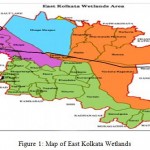 |
Figure 1: Map of East Kolkata Wetlands |
Review of Literature
There are some reports on microbial biodiversity at national and international level. The biota of marine microorganisms has developed unique metabolic and physiological functions that not only ensure survival in extreme habitats, but also offer a potential for the production of novel enzymes for potential exploitation. Mangrove ecosystem is nutritionally very rich and widely diverse group of organisms can survive in this extreme habitat. Out of the large number of species examined, only a fraction of marine bacteria have been isolated and cultured. Among them, alkaliphilic Bacillus strains are of considerable importance in biotechnological applications (Fritze et al., 1990, Kumar. and Takagi, 1999, Kumar et al. 2004). A novel B. lehensis (MLB2 (T)) was reported recent from Leh region, Jammu and Kashmir and B. licheniformis SPT27, a producer of extracellular alpha amylase was isolated from the alkaline soil of the eastern coastal region of Bombay, Gujarat. However, in an extensive survey of microbial diversity at marine salterns near Bhavnagar, Gujarat, no Bacillus sp. was documented (Ghosh, et al. 2007, Aiyer, 2004, Deve, and Desai, 2006).
Pushpangadan and Narayanan (2001) made attempt to organize systematics and biodiversity research in India. Diversity of microflora in the gut and casts of tropical composting earthworms reared on different substrates was studied by Parthasarathi et al. (2007). They isolated and identified the strains able to fix nitrogen, produce extracellular enzymes like protease, cellulase, xylanase, and amylase, and solubilize inorganic phosphates. Molecular analysis of microbial diversity of Lonar soda lake (Indian Soda Lake) was analysed by Wani et.al. (2006). Bacterial diversity of East Calcutta wetland and their possible identification was done by Ghosh et.al. (2007).
Surajit Das et al. (2006) reported about the marine microbial diversity & its importance. Halobacteria (Halococcus) isolated from mangrove sediments produce L-asparaginase etc. Joshi et al. (2008) reported the cultivable bacterial diversity alkaline Lonar Lake, India. Most of their isolates produced biotechnologically important enzymes at alkaline pH, while only two isolates (ARI 351 and ARI 341) showed the presence of polyhydroxyalkcanoate (PHA) and exopolysaccharide (EPS), respectively.
East Calcutta Wetland is low lying area of about 12500 hectares on the eastern region of Calcutta. It is acting as a natural sewage treatment plant to the city and side by side generates product like paddy, vegetables and fish utilizing the sewage. It receives effluents from domestic activities, industries, tanneries, battery manufacturing units as well as health sectors. The purification of the waste products is mainly based on microbial activity. The hot and humid climate all throughout the year favors this site to act as an incubator for diverse group of microbes. Thus the site was selected to explore wide variety of microbes which can be applicable in biotechnology and bioremediation. Bacterial diversity of East Calcutta wetland and their possible identification was done by Ghosh et.al. (2007).
Aim of the present Work
The central aim of the present work to isolate the biologically diverse group of fungi from locality of selected natural spot of East Kolkata wetland of South 24-parganas including Gosaba Island . The purification and indexing of the isolates will be done thereafter. The microbes will be preserved for future use. The identification and cataloguing of the isolated microbes will be done. As there is no such report on the micro fungi of above said area, this study will help to prepare a catalogue/data bank of total fungi including micro fungi of the selected area.
Materials and methods
Soils were collected from four different agro-ecosystems of Dhapa landfill site at the East Kolkata Wetlands . Slide were prepared by staining the mycelium by cotton blue dye and observed under oil immersion microscope. Identification of the microbes have done morphologically by light microscopy, Phase contrast Microscopy and 3-D Transmission electronic microscope (model no-TM1500) and picture available in Pictorial Atlas Of Soil and Seed Fungi (Author- Tsugeo watanabe )
Isolation of Soil Sample
Saline Soil samples were collected from different corner of East Kolkata Wetlands . The sample were taken at least 50 inches distance from shore and from 7 inches depth and mixed well and put in sterile plastic containers . These were then shifted to the laboratory for further analysis . The laboratory which were used for conducting the said work was , Department of Microbiology , Bidhannagar College , Salt Lake , Govt. of West Bengal .
So all the soil analysis was carried out there . Soil sample were collected from the localities like Tree Garden Land ( Bally -1 & 2 ) , Beside Tree ( Jharkhali ) , Beside Pond (Hirenmaypur), Rice Land (Hirenmaypur, Gosaba Bally – 1 & 2), Trees Land (Hirenmaypur), Rice Land (Main Gosaba, 9 No. Bali), Garden Land (9 No. Bali, Malopasa, Rajabazar), Under Trees Land (Malopasa), Bantala tannery, Dhapa, Bherry
Isolation of Fungi
Fungus were isolated by 10 gms dry soil in 90 ml sterile distilled water, shake well for 15 minutes and kept for one hour for settling. After that serial dilution were made in 9 ml sterile distilled water. 0.1 ml sample were poured in agar plates and spread well by glass spreader and kept in incubator at 320 C. Optimization of the growth media were done by different media like Potato Dextrose Media, Molt Agar Media and Czapek-Dox agar media and Czapek-Dox agar media was found to be most suitable. Cultivations were made on both still culture or shaking culture methods. Purifications were done by tube dilution methods.
Composition of Potato Dextrose Ager
Potato – 200 gm
Dextrose – 20 gm
Ager – 20 gm
Distilled Water – 1000 ml
pH – 5.6
Procedure
Fungus were isolated by 10 gms soil in 90 ml distil water, shake well and kept for settling. pH was measured by pH- meter. After that serial dilution were made in 9 ml sterile distilled water. 0.1 ml sample were poured in agar plates and spread well by glass spreader and kept in incubator at 370
Purifications were done by tube dilution methods. Preservation was done in Liquid paraffin .
Result and Discussion
Isolation of soil samples
Soil sample were collected from different corners such as Trees Garden Land (Bally – 1 & 2), Beside Tree (Jarkhali), Beside Pond (Hirenmaypur), Rice Land (Hirenmaypur, Gosaba Bally – 1 & 2), Trees Land (Hirenmaypur), Rice Land (Main Gosaba, 9 No. Bali), Garden Land (9 No. Bali, Malopasa, Rajabazar), Under Trees Land (Malopasa), Bantala tannery, Dhapa, Bherry .
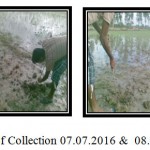 |
Figure 2: Date of Collection 07.07.2016 & 08.07.2016 (Near Gosaba) |
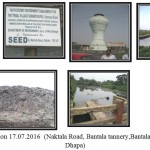 |
Figure 3: date of Collection 17.07.2016 (Naktala Road, Bantala tannery,Bantala sewage desposal cannel, Dhapa) |
Plate Cultures of the Isolated Organism
After inoculation of soil sample into Potato Dextrose Agar plate various type of fungus colony were appeared.
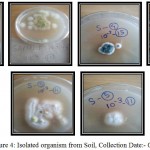 |
Figure 4: Isolated organism from Soil, Collection Date:- 07/07/2016 |
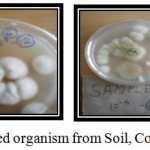 |
Figure 5: Isolated organism from Soil, Collection Date :-08/07/2016 |
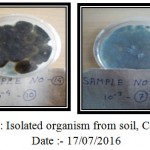 |
Figure 6: Isolated organism from soil, Collection Date :- 17/07/2016 |
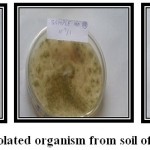 |
Figure 7: Isolated organism from soil of Dhapa |
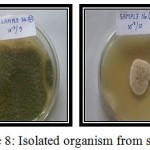 |
Figure 8: Isolated organism from soil of Bhery |
Table 1: Represent the microbial count of the soil sample collected on 07.07.2016
| Soil Sample No. | Locality | Soil Type | Land Type | pH | No of C.F.U | |||
| 24hr | 48hr | |||||||
| 103 | 104 | 103 | 104 | |||||
|
S – 1 |
Trees Garden Land (Bally – 1)
|
Wet |
Horizontal |
5 | R – 1
TNTC R – 2 TNTC |
R – 1
90 R – 2 100 |
R – 1
TNTC R – 2 TNTC |
R – 1 100
R – 2 35 |
|
S – 4 |
Rice Land (Bally 2 ) |
Wet |
Horizontal |
6 | R – 1
134 R – 2 18 |
R – 1
152 R – 2 25 |
R – 1
234 R – 2 46
|
R – 1
143 R – 2 46 |
|
S – 5 |
Rice Land (bally1) |
Wet |
Horizontal |
4.7 | R – 1
8 R – 2 12 |
R – 1
2 R – 2 3 |
R – 1
31 R – 2 10 |
R – 1
28 R – 2 25 |
|
S – 7 |
Trees Garden Land (Bally2 Satyanarayanpur,Gosaba) | Minimum Wet |
Horizontal |
5 | R – 1
TNTC R – 2 125 |
R – 1
121 R – 2 65 |
||
Table 2: Represent the microbial count of the soil sample collected on 08.07.2016
| Soil Sample No. | Locality | Soil Type | Land Type | pH | No of C.F.U | |||
| 24hr | 48hr | |||||||
| 103 | 104 | 103 | 104 | |||||
| S – 2 |
Beside Tree (Jarkhali) |
Dry |
Vertical |
6 |
R – 1
281 R – 2 61 |
R – 1
102 R – 2 75 |
R – 1
472 R – 2 220 |
R – 1
187 R – 2 150 |
| S – 3 |
Beside Pond (Hirenmmypur) |
Wet |
Vertical |
5 |
R – 1
100 R – 2 150 |
R – 1
25 R – 2 80 |
||
| S – 6 |
Rice Land (Hirenmypur) |
Wet |
Horizontal |
4.7 |
R – 1
0 R – 2 1 |
R – 1
0 0 |
R – 1
25 R – 2 29 |
R – 1
27 R – 2 18 |
| S – 8 | Rice Land (Hirenmypur) |
Wet |
Vertical |
5 |
R – 1
90 R – 2 180 |
R – 1
72 R – 2 40 |
||
| S – 9 |
Trees Land P. S. – Basanti
|
Dry |
Vertical |
5 |
R – 1
TNTC TNTC |
R – 1
70 R – 2 65 |
||
Table 3 : Represent the microbial count of the soil sample collected on 17.07.2016
| Soil Sample No. | Locality | Soil Type | Land Type | pH | No of C.F.U | |||
| 24hr | 48hr | |||||||
| 103 | 104 | 103 | 104 | |||||
| S – 10 |
Garden land (Malopasa, Gosaba) |
Wet |
Horizontal |
6.5 | R – 1
87 R – 2 94 |
R – 1
36 R – 2 55 |
R – 1
100 R – 2 98 |
R – 1
92 R – 2 54 |
| S – 11 | Garden Land (Rajabazar, Gosaba)
(Sample 2) |
Wet |
Horizontal |
4.5 | R – 1
60 R – 2 70 |
R – 1
25 R – 2 17 |
R – 1
50 R – 2 42 |
R – 1
18 R – 2 12 |
| S – 12 |
Rice Land 9 no Bally (Gosaba) |
Wet |
Vertical |
6 | R – 1
145 R – 2 130 |
R – 1
104 R – 2 96 |
R – 1
50 R – 2 45 |
R – 1
84 R – 2 75 |
| S – 13 |
Garden Land (Rajabazar, Gosaba) |
Wet |
Horizontal |
5.2 | R – 1
18 R – 2 13 |
R – 1
7 R – 2 5 |
R – 1
550 R – 2 460 |
R – 1
TNTC R – 2 TNTC |
| S – 14 |
Rice Land (Main Gosaba) |
Wet |
Horizontal |
5.5 | R – 1
198 R – 2 150 |
R – 1
36 R – 2 40 |
R – 1
66 R – 2 55 |
R – 1
36 R – 2 27 |
| S – 15 |
Gosaba Land 9 no Bally Gosaba |
Wet |
Horizontal |
5.3 | R – 1
208 R – 2 180 |
R – 1
35 R – 2 15 |
R – 1
260 R – 2 204 |
R – 1
88 R – 2 91 |
| S – 16 | Under Trees Land, Gosaba Main, Malopasa |
Wet |
Vertical |
6 | R – 1
4 R – 2 8 |
R – 1
8 R – 2 9 |
R – 1
189 R – 2 160 |
R – 1
96 R – 2 196 |
Table 4: Represent the microbial count of the soil sample collected on 17.07.201
| Soil Sample No. | Locality | pH | No of C.F.U | |
| 24hr | ||||
| 103 | 104 | |||
| S – 17 | Dhapa |
5.3 |
R – 1
480 R – 2 520 |
R – 1
98 R – 2 87 |
| S – 18 | Dhapa |
5.3 |
R – 1
328 R – 2 440 |
R – 1
104 R – 2 160 |
| S – 19 | Dhapa |
5.3 |
R – 1
272 R – 2 300 |
R – 1
31 R – 2 41 |
| S – 22 | Bhery |
5 |
R – 1
268 R – 2 176 |
R – 1
50 R – 2 36 |
| S – 23 | Bhery |
5 |
R – 1
201 R – 2 220 |
R – 1
70 R – 2 65 |
Purification and Preservation
Organisms were Purified by serial dilution method and inoculated in a slant, left for incubation at 37°. After sufficient growth slants were preserved by autoclaved paraffin.
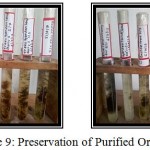 |
Figure 9: Preservation of Purified Organism |
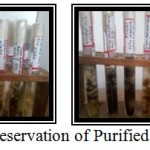 |
Figure 10: Preservation of Purified Organism |
Observation Tables
Table 5: Date Of Collection 07/07/2016
| Soil Sample No. | Isolate Number | Type | Appearance and colour | |
| 103
|
104
|
|||
|
S – 1 |
S – 1/1 | Fungus | Pale Brown | – |
| S – 1/2 | Fungus | Cotton White | – | |
| S – 1/8 | Fungus | Pale Brown | – | |
| S – 1/3 | Fungus | – | Cotton White | |
| S – 1/4 | Fungus | – | Green | |
| S – 1/5 | Fungus | – | White and Green | |
| S – 1/6 | Fungus | – | Brown and White | |
| S – 1/7 | Fungus | – | Velvet like, Pale white in colour | |
|
S – 4 |
S – 1/8 | Fungus | White | – |
| S – 1/9 | Fungus | Black | – | |
| S – 1/14 | Fungus | Greenish flat | – | |
| S – 1/15 | Fungus | Greenish domed | – | |
| S – 1/16 | Bacteria | Red | – | |
| S – 1/7 | Fungus | – | Dark green within white | |
| S – 1/12 | Fungus | – | White | |
| S – 1/13 | Bacteria | – | Red | |
|
S – 5 |
S – 1/13 | Fungus | White flat dot like | – |
| S – 1/14 | Fungus | White and green | – | |
| S – 1/15 | Fungus | White | – | |
| S – 1/2 | Fungus | – | Cotton white | |
|
S – 7 |
S – 1/1 | Bacteria | – | Brownish antibiotic secreting |
| S – 1/2 | Bacteria | – | brownish ring like ac | |
| S – 1/3 | Bacteria | – | antibiotic secreting | |
| S – 1/4 | Bacteria | – | chalky white antibiotic secreting | |
| S – 1/5 | Bacteria | – | white surrounded by black dots antibiotic secreting | |
Table 6: Date of Collection 08/07/2016
| Soil Sample No. | Isolate Number | Type | Appearance and colour | |
| 103 | 104 | |||
| S – 2 | S – 2/3 | Fungus | Irregular shape green | – |
| S – 2/4 | Bacteria | Pale red round | – | |
| S – 2/5 | Fungus | White | – | |
| S – 2/6 | Fungus | Black spore | – | |
| S – 2/1 | Fungus | – | Green, base is red | |
| S – 2/2 | Fungus | – | Chalky white | |
| S – 2/10 | Fungus | – | White | |
| S – 2/11 | Fungus | – | Light green | |
| S – 3 | S – 3/10 | Bacteria | – | Black and white ring like |
| S – 6 | S – 6/9 | Fungus | Black | – |
| S – 6/10 | Fungus | Green | – | |
| S – 6/11 | Fungus | – | Black with white dot | |
| S – 8 | S – 8/6 | Fungus | Green | – |
| S – 8/7 | Bacteria | Cream colour | – | |
| S – 8/9 | Bacteria | – | Black and white, outer ring is white | |
| S – 9 | S – 9/8 | Bacteria | – | Chalky white |
Table 7: Date of Collection 17/07/2016
| Soil Sample No. | Isolate Number | Type | Appearance and colour | |
| 103
|
104
|
|||
|
S – 11 |
S – 11/11 | Fungus | Red in white | – |
| S – 11/12 | Fungus | White | – | |
|
S – 12 |
S – 12/1 | Fungus | – | Black and chalky dots, crenated |
| S – 12/2 | Bacteria | – | Jelly like | |
|
S – 14 |
S – 14/6 | Fungus | Brownish | Chalky white |
| S – 14/7 | Fungus | Greenish | – | |
| S – 14/8 | Fungus | Greenish, base is brown | – | |
| S – 14/9 | Bacteria | Pale red | – | |
| S – 14/3 | Bacteria | – | White | |
| S – 14/4 | Bacteria | – | Chalky round | |
| S – 14/5 | Bacteria | – | Reddish round | |
| S – 14/10 | Fungus | – | Black | |
Table 8: Date of Collection 17/07/2016
| Soil Sample No. | Isolate Number | Type | Appearance and colour | |
| 103 | 104 | |||
| S – 17 | S – 17/8 | Fungus | Cotton white, base is yellow | – |
| S – 17/11 | Fungus | White spores, base orange | – | |
| S – 17/5 | Fungus | – | Fluffy cotton | |
| S – 18 | S – 18/1 | Fungus | Tiny green spores | – |
| S – 18/12 | Fungus | – | Brown | |
| S – 18/14 | Fungus | – | Brown | |
| S – 19 | S – 19/7 | Fungus | Cotton white | – |
| S – 19/3 | Fungus | – | Black spore | |
| S – 19/13 | Bacteria | – | White, in middle red dots | |
| S – 22 | S – 22/6 | Fungus | Dark green | – |
| S – 22/9 | Fungus | Base green, top slight cotton like | – | |
Identification
Based on microscopically examination (LEICA DM 1000) and picture available in Pictorial Atlas Of Soil and Seed Fungi (Author- Tsugeo watanabe ) some fungi are identified
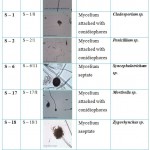 |
Table 9 |
Conclusion
An understanding of Microbial Diversity is of enormous importance because it will help in understanding different processes of earth and which may present potent novel microorganism which will play a vital role in screening of bioactive compound . One of the most unexplored area relating to biodiversity in west Bengal is selected natural spot of East Kolkata Wetland of the present study , because there is no such records of available fungi in these areas . Isolation , documentation and conservation of these resources are necessary an important because the study of these diverse conditions may play an important role in future in this field .
The present work deals with seven micro-organisms , which was identified by microscopic studies after isolating and purifying several fungi from diverse areas of East Kolkata Wetland . It is expected that out of seven isolated organisms one or two new genus of fungi may be obtained . These are several characteristic feature like pesticide degradation , chromium degradation , cellulase degradation capabilities and may producing any important medical molecule etc. Which were not explored due to lack of time may be explore in future .
Acknowledgment
The author would like to thanks from his inner core of heart to the Department of Microbiology , Bidhannagar College , Salt Lake , Govt. of West Bengal for conducting the above work at said laboratory and department of Environment, Govt. of West Bengal for financial assistance to main author Dr. Abul Kalam, the principal investigator of this project.
References
- Adarsh V. K., Mishra S. M., Sudarshan M. C and Thakur A. R. et al., Studies on metal microbe interaction of three bacterial isolates from East Calcutta Wetland. 2007.
- Vibha B and Neelam G. Importance of Exploration of Microbial Biodiversity. 2012.
- Chakraborty D., Ghosh D and Niyogi S. Calcutta pollutants: Part 1: Appraisal of some heavy metals in Calcutta City sewage and sludge in use for fisheries and agriculture. Int. J. nviron. 1987.
- Chattopadhyay B., Chatterjee A and Mukhopadhyay S. K. Bioaccumulation of metals in the East Calcutta Wetland Ecosystem. Aquatic Ecosyst. Health Manage. 2002.
- Chaudhuri S. R and Thakur A. R. Microbial genetic resource mapping of East Calcutta Wetlands. 2006.
- Chaudhuri S. R., Salodkar S., Sudarshan M and Thakur A. R. Integrated resource recovery at east Calcutta wetland-how safe is these? Am. J. Agric. Biol. Sci. 2007.
- Pictorial Atlas Of Soil and Seed Fungi by Tsugeo watanabe .

This work is licensed under a Creative Commons Attribution 4.0 International License.





